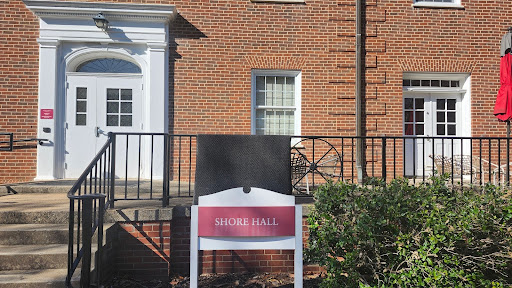James Shields steps up as interim MED head
James Shields ‘00, director of The Bonner Center for Community Service & Learning, reads an excerpt from The Reminiscence of Levi Coffin in front of the Underground Railroad Tree. // Photo by Nicole Zelniker/Guilfordian
The Multicultural Education Department is getting an upgrade, even as it loses a director — the latest in a string of departures.
In an email to the community on March 27, President Jane Fernandes announced that the MED director is now a part of the senior team. But that position has been vacated by Stephanie Chang, the former director, and is now occupied in the interim by James Shields, director of the Bonner Center.
“This is when cloning technology would be helpful,” said Shields. “It’s hard to be in several places at the same time, but we’re working it out.”
Chang recently left Guilford College after eight months to serve as the assistant vice president for student life, diversity and inclusion at the University of Delaware. Over spring break, Fernandes reached out to Shields to ask him to serve in the interim role.
“James has been a long-time supporter of the MED,” said Irving Zavaleta Jimenez, assistant director for multicultural education and Latino community coordinator. “I’m very glad that James is able to step (into) this role. He’s also someone who is respected in the community.”
The position of a new director of the MED has been posted to the College’s job opportunities page, and Fernandes said that they hope to have the position filled by August 1.
“We’re toward the end of the semester,” said Shields. “Folks are looking for jobs now. So this is the perfect time to post a job like this.”
Chang’s departure, however, is just one in a series of departures from the MED in recent years.
Jorge Zeballos, who served as the director for diversity training and development at Guilford, left in 2014 after seven years of working at Guilford. Jada Drew, the last director of Multicultural Education before Chang, left in 2015 after seven years at Guilford.
Between Drew’s departure and Chang’s arrival in July 2016, the department was run entirely by Jimenez and LGBTQQA Coordinator Parker Hurley. Last semester, Hurley left the College after four years, meaning that currently the only full-time, non-interim staff person is Jimenez.
“Each year, you saw (the MED) dwindle,” said Hurley in a phone interview. “Even though (the College) was recruiting … black and brown bodies, the support didn’t increase.”
Shields was cautious, however, about ascribing the departures to any pattern.
“I wouldn’t say there’s any reason structurally about the MED itself that would cause people to move on,” said Shields. “I mean, all those people … who moved on moved on for various reasons.”
The Guilfordian reached out to all the people we knew of who had left the MED in the past three years to ask why they had left and why they thought others might have.
“I resigned from Guilford for entrepreneurial pursuits,” wrote Drew in an email response. “The high turnover is new. Prior to when I left, people have been in those positions 3-8 years on average, which is average for multicultural affairs.”
Zeballos declined to comment for this article, and Chang could not be reached.
“When this kind of turnover happens, we cannot just point (to) one sole reason,” said Jimenez. “I think it’s a lot of factors. The pay is one of them. The institutional support and resources is another. Diversity work is also very hard to do. It’s really challenging work, very exhausting.”
For Hurley, the support was just too low for the amount of work involved.
“It didn’t make sense for me and my family to make those sacrifices anymore,” he said. “I’m showing up for Guilford, but Guilford isn’t really showing up for me.”
After over four years working at Guilford, Hurley also found the lack of institutional progress on campus frustrating.
“If they were really trying to be about (social justice) … it would be all hands on deck, not perpetually covering your ass and doing the minimum required,” he said.
In terms of pay, the new director position is listed on Guilford’s hiring page with a hiring range of $46,013 to $59,817. According to a 2016 article in The Chronicle of Higher Education titled “Median Salaries of College Administrators, 2015-2016,” the median salary of a chief diversity officer at a baccalaureate granting institution was $91,350, nearly twice as much as the high end of Guilford’s hiring range.
“I think we recognize the reality of the financial situation of the College,” said Shields. “We’ve been used to doing more with less.”
Whoever the next director of the MED is will have new opportunities as a member of the senior staff, but they may also face the on-going challenges of doing diversity work at Guilford College.









